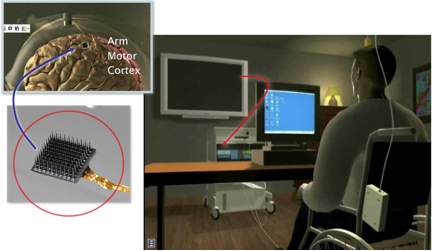Brain-Computer InterfacesTherapeutic Potential of NeurotechnologyJohn P. Donoghue, PhD To overcome damage to spinal cord or body caused by injury, stroke, or disease, technology is under development to create neural interface systems, sometimes called a brain-computer interface (BCI), to sense motor intentions and reconnect them to the outside world. Electrical stimulation devices that restore hearing to the deaf (cochlear implants), as well as interventions to stop the tremor and rigidity of Parkinson’s disease (deep brain stimulators) are already used by more than approximately 500,000 people. Furthermore, devices to restore some sight to the blind became available in 2013. These neural interfaces represent the beginning of an age of neurotechnology in which promising advances are being realized to provide a range of devices to diagnose and treat nervous system disease and restore lost function. Using the Mind Alone to Signal MovementIn recent years, several tetraplegic people, who cannot move their body, have had tiny sensors, smaller than a baby aspirin tablet, implanted beneath their skull in the motor cortex, the brain area that generates movement commands. Each of the people in this ongoing, early stage clinical trial are unable to move their arms, body or legs. Even so, with the addition of the BCI linking the firing of a small group of motor cortex neurons to a computer interface, the subjects were able to make a computer cursor move as if they were controlling a mouse with their hand. The trial using this BrainGate neural interface has demonstrated how they gained the ability to type messages using only their thoughts to manipulate a cursor. Is Paralysis Treatment Next?In addition, work has advanced to connect brain signals with stimulators implanted inside the body and connected to muscles. Proof of concept of such a system was demonstrated in 2017. Damaged natural connections between the brain and muscle are bridged by the system’s hardware and electrical impulses, allowing people with paralysis to move their arms. Epilepsy Monitoring Also ConsideredBeyond that application, brain sensors that are able to measure minute changes in brain activity may also be used to monitor potential warning signs, such as possible onset of an epileptic seizure. These advances suggest an entirely new set of solutions is on the horizon that could treat a wide range of nervous system disorders and restore function – and life quality – for people with disabilities, their caregivers and loved ones. Please note: This information should not be used as a substitute for medical treatment and advice. Always consult a medical professional about any health-related questions or concerns.
BrainGate neural interface system. The sensor, which measures 4 x 4 mm, is implanted in the motor cortex, where it detects minute electrical impulses signaling commands to move the arm. From initial human clinical trials we now know that these signals are present even long after spinal cord injury or stroke. The signals can be passed through a computer (red arrow) to be converted into a command the moves a computer cursor when the user thinks about moving it.
ResourceWIKISTIM – This free-to-use collaborative, searchable wiki of published primary neuromodulation therapy research was created in 2013 as a resource for the global neuromodulation community to extend the utility of published clinical research. The goals of WIKISTIM are to improve patient care and the quality of research reports, foster education and communication, reveal research needs, and support the practice of evidence–based medicine. September 27, 2017 |
| Last Updated on Friday, December 17, 2021 06:47 PM |

